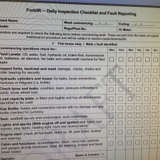Information
-
Title (Insert name of plant)
-
Two Post Car Hoist (Depot)
-
Name of operator conducting daily check of plant
-
Conducted on
-
Make and model
-
Registration or plant identification number (If applicable)?
-
Hour meter at commencement of shift (if applicable)
-
Location
-
Operators are required to check the following items before commencing work. These records from the basis of a plant maintenance procedure and will be subject to random inspections/audits.
-
Inspect the following items to ensure plant is safe to use.
If plant is defective and determined to be unsafe to use than the operator shall tag-out and report the problem to the workshop or their supervisor for further advice. -
Rating for inspection of plant as follows:
1. Safe to use GREEN
2. Fault detected, but safe to use YELLOW (Note: Do not use if there is risk of harm to worker(s) or plant damage!)
3. Unsafe to use, Tag-out and report RED
1. Plant Checklist
CHECKLIST OF PLANT (Check at minimum daily before using hoist)
1. CHECK WARNING STICKERS AND COMPLIANCE PLATE
-
1. Worker has been inducted into safe operation of plant (SOP)?
-
2. Operators instruction manual available?
-
3. Compliance plate attached and legible?
-
4. Operating controls clearly displayed?
-
5. Check for any maintenance tags (damage to hoist or switchboard)?
-
6. Emergency shut-off switch is available and functioning correctly?
2. LIFTING EQUIPMENT
-
1. Lifting flexible steel wire cables and sheaves visually inspected for wear or damage?
-
2. Inspect all support lifting arms and adjustment locks for proper operation and damage?
-
3. Inspect rubber pass for wear or damage?
-
4. Inspect up-right safety locking mechanisms for security and working effectively?
-
5. Inspect all moving parts to ensure they are in good condition?
3. HOIST GUARDING
-
1. Inspect all goods are fitted correctly and secure?
4. HYDRAULICS
-
1. Check hydraulic reservoir is full to level indicated?
-
2. Hydraulic cylinders are not leaking and in good condition?
-
3. Hydraulic hoses not damaged or brittle, no loose connections or damaged fittings?<br>Not worn with wire braid exposed?
5. WORK AND LIFTING ZONE
-
1. Check lift area is clear of obstructions before commencing work (Particularly when lifting and lowering vehicles)?
6. DETAILS OF PLANT OPERATOR
-
Name and signature of operator checking plant
7. CHECKING OFFICER DETAILS
-
Name and signature of checking officer
2. Workshop Repair and Return to Service
2. Workshop repair and return to service details
-
Insert job number and any details required.
-
Date of return to service
-
Repaired by name and signature
-
Authorised by team leader or supervisor name and signature
3. Induction for Safe Operation of Plant
3. Induction for Safe Operation of Plant (Two Post Car Hoist).
-
1. All operators shall be trained in the safe operation of this plant. Date of induction, name and signature. Name and signature of authorised person conducting induction.
-
Comments
-
2. Always position the arms and adapters properly out of the way before pulling the vehicle into or out of the bay. (Failure to do so could cause damage to the vehicle and/or lift).
-
Comments
-
3. Do not overload lift. The SWL of lift should be displayed on the hoist.
-
Comments
-
4. Positioning of the vehicle is very important: - Position arms to the vehicle manufactures recommended pick-up points. - Raise the lift until contact is made with the vehicle. - Make sure that the arms have properly engaged the vehicle before raising the lift to a working point.
-
Comments
-
5. Conduct a check of work zone and make sure it is clear of all persons and materials when the following applies: - the hoist is raised and disengaged - the hoist is being raised or lowered with or without vehicles - all materials that may interfere or cause damage to hoist are removed.
-
Comments
-
6. Inspect the lift daily. The lift should never be operated if it has damaged components or is malfunctioning. Only qualified technicians shall service lift. Replace damaged components with manufacturer's parts or the equivelent.
-
Comments
-
7. Warning: - Keep the area around the lift clear of obstacles! - Never override the the self- returning lift controls! - Use safety stands (Acro props) when removing or installing heavy vehicle components.
-
Comments
-
8. To reduce risk of injury, keep hair, loose clothing, fingers and all body parts clear of moving parts.
-
Comments
-
9. To reduce the risk of electric shock, do not use lift when wet (cleaning or rain).
-
Comments
-
10. To reduce the risk of fire, do not operate equipment in the vicinity of open containers or flammable liquids (petrol).
-
Comments
-
11. Us the lift according to the manufacturer's requirements (Only use manufacturer's recommended attachments).
-
Comments
-
12. Take caution with unusual vehicles (long wheel bases) may not be suitable for lifting seek advice or check with manufacturer's specifications.
-
Comments
-
13. General maintenance and trouble shooting may be conducted by the owner/operator. Technical repairs to be conducted by trained lift service personnel, but not limited to the following: - cylinder replacement - carriage and safety latch replacement - leg replacement - overhead structure replacement.
-
Comments
-
14. All persons who will be in the vicinity of the lift when it is in use should familiarise themselves with the following: - Caution - Warning and safety related decals supplied with the lift and replace them If they are illegible or damaged.
-
Comments
Details of authorised person conducting induction into safe operating of plant
-
Name, date and signature
Details of person being inducted into the safe operating of plant (SOP).
-
Name, date and signature














